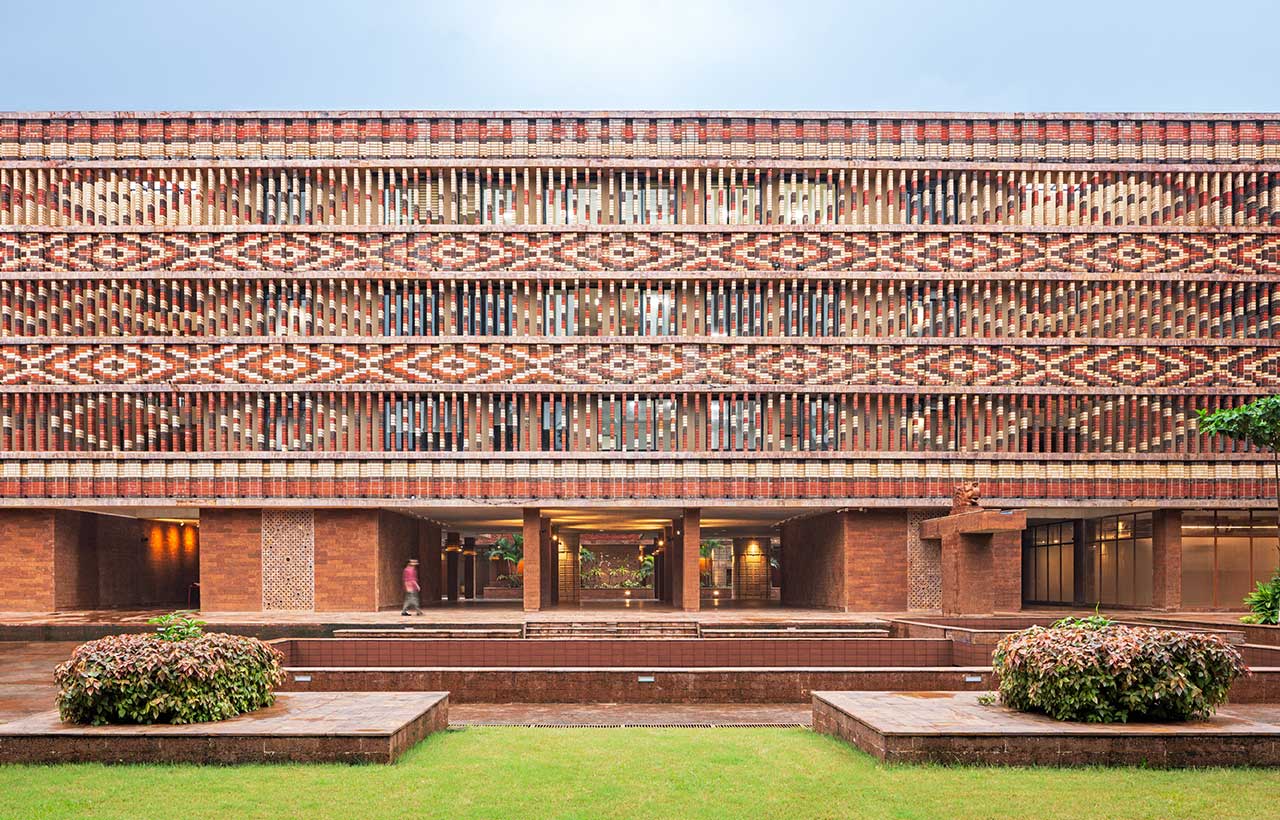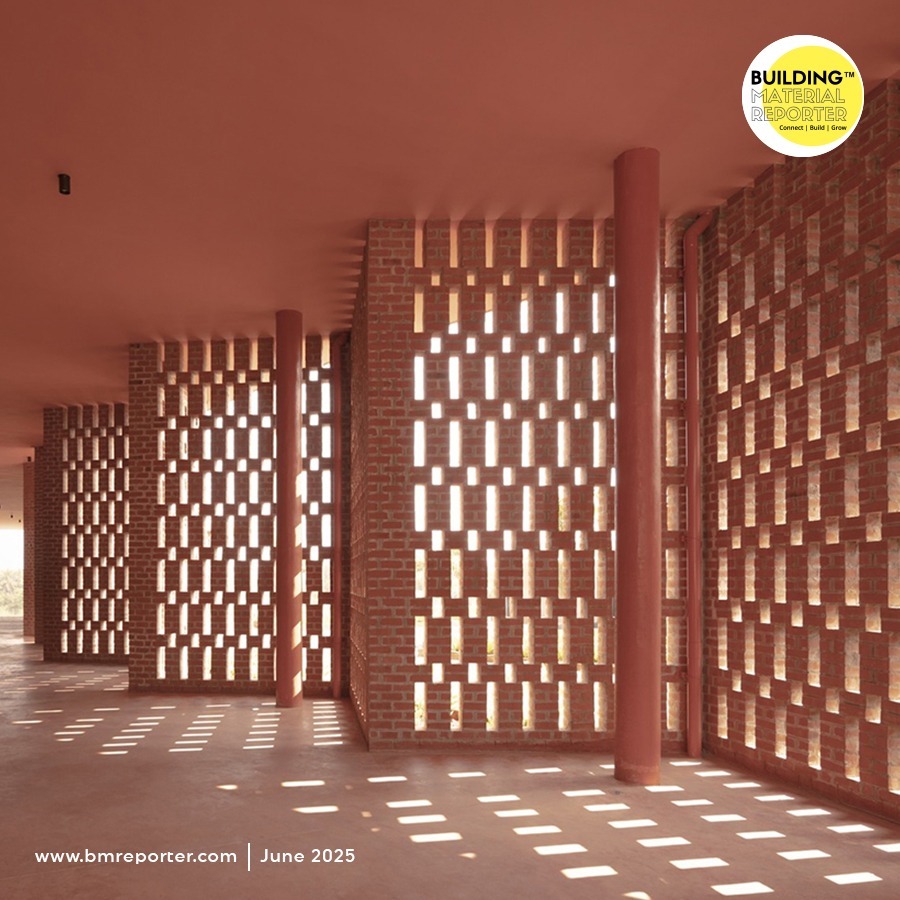Krushi Bhawan: Celebrating Culture and Life
- December 14, 2022
- By: Syed Md Ehteshamul Hasan
- INFLUENCERS
 Krushi Bhawan is located in Bhubaneshwar, the state capital of Odisha. Home to multiple agrarian communities, the state is the third largest contributor to India’s grain supply. A government facility that re-imagines the relationship between the state and its people Krushi Bhawan is a facility developed for Government of Odisha’s Department of Agriculture & Farmers Empowerment. The 130,000 sq. ft. administrative center has been designed as an office for a team of nearly 600 people, in addition to accommodating spaces for community engagement and learning.
Krushi Bhawan is located in Bhubaneshwar, the state capital of Odisha. Home to multiple agrarian communities, the state is the third largest contributor to India’s grain supply. A government facility that re-imagines the relationship between the state and its people Krushi Bhawan is a facility developed for Government of Odisha’s Department of Agriculture & Farmers Empowerment. The 130,000 sq. ft. administrative center has been designed as an office for a team of nearly 600 people, in addition to accommodating spaces for community engagement and learning.
 Krushi Bhawan was originally intended as a purely administrative space. It took a cue from Königsberger‘s original vision for Bhubaneswar where he saw the Capitol Complex with a host of government offices becoming “a vibrant point of public life”. Thus, the architect's suggestion to include public functions and community spaces to create a building that would add to the city’s social infrastructure was willingly embraced by the Clients. The new campus sits adjacent to the old ministry office with several ancillary structures of power in the vicinity, such as the Police Commissionerate Building, and the State Guest House. This attempt to include the building in the public domain has been achieved by designing the ground floor as a free-flowing public space that opens out into a plaza, which is an extension of the street. Congruent with the project objective, the ground floor comprises a learning center, a gallery, an auditorium, a library, and training rooms. Similarly, the rooftop has been designed to house urban farming exhibits and demonstration of agricultural best practices.
Krushi Bhawan was originally intended as a purely administrative space. It took a cue from Königsberger‘s original vision for Bhubaneswar where he saw the Capitol Complex with a host of government offices becoming “a vibrant point of public life”. Thus, the architect's suggestion to include public functions and community spaces to create a building that would add to the city’s social infrastructure was willingly embraced by the Clients. The new campus sits adjacent to the old ministry office with several ancillary structures of power in the vicinity, such as the Police Commissionerate Building, and the State Guest House. This attempt to include the building in the public domain has been achieved by designing the ground floor as a free-flowing public space that opens out into a plaza, which is an extension of the street. Congruent with the project objective, the ground floor comprises a learning center, a gallery, an auditorium, a library, and training rooms. Similarly, the rooftop has been designed to house urban farming exhibits and demonstration of agricultural best practices.
The Spatial Arrangement of Spaces
The offices for the State Department and Directorates which require restricted access have been placed on the first, second, and third floors. This allows the offices to be secured, making it possible to keep most of the other facilities open to the public even on holidays. Through exhibitions, workshops, haats (weekly markets), lectures, and school visits, these public spaces become a hub for imparting skills and sharing knowledge that engages diverse sections of the city’s population. As befits the climatic conditions of the region, the design scheme for Krushi Bhawan consists of a central courtyard that opens through a series of colonnades into the Public Plaza. The Public Plaza consists of a garden with native Flora, featuring an informal amphitheater and a pond that cools the forecourt. The primary entrance pathway is lined by laterite lattices and trees and performs multiple functions from a common area for employees to congregate in and eat together during lunch hour, to a place for hosting small gatherings. Thus, the ground floor functions as a public node that turns the traditionally austere image of government facilities into one that is welcoming, inclusive, and collectively owned.
Materiality
The distinct visual identity of Krushi Bhawan has been derived from regional materials and vernacular narratives, expressed in a manner that is responsive to the local climate.
 Over 100 highly-skilled artisans have come together to create a vibrant and contemporary narrative of traditional Odia craft depicting agricultural folklore and mythological stories, envisioned at an unprecedented architectural scale. For instance, the tribal craft of dhokra (cast metal craft) has been adapted to make light fixtures that wrap around the ground floor columns, as well as metal screens that line the building corridors. The pedestal level and North Wing use locally-sourced laterite and khondalite stone. Hand-carved khondalite lattices provide a sense of enclosure to the Central Court. Similarly, agricultural motifs have been displayed across the building through a variety of craft techniques--such as the bas-relief carvings in laterite along the Public Plaza, which depict ripe paddy crops illustrated in the Odia Pattachitra (cloth-based scroll paintings) style. In the Central Court, a Crop Calendar has been created on a stone inlay floor, which displays the harvesting cycles for the most prevalent crops in Odia farmlands. The upper floors of Krushi Bhawan feature a distinctive brick façade inspired by Ikat patterns of Odisha handlooms, created using clay in three different colors that represent the geographical diversity of the region. This brick-louvered screen wraps around the building like a second skin.
Over 100 highly-skilled artisans have come together to create a vibrant and contemporary narrative of traditional Odia craft depicting agricultural folklore and mythological stories, envisioned at an unprecedented architectural scale. For instance, the tribal craft of dhokra (cast metal craft) has been adapted to make light fixtures that wrap around the ground floor columns, as well as metal screens that line the building corridors. The pedestal level and North Wing use locally-sourced laterite and khondalite stone. Hand-carved khondalite lattices provide a sense of enclosure to the Central Court. Similarly, agricultural motifs have been displayed across the building through a variety of craft techniques--such as the bas-relief carvings in laterite along the Public Plaza, which depict ripe paddy crops illustrated in the Odia Pattachitra (cloth-based scroll paintings) style. In the Central Court, a Crop Calendar has been created on a stone inlay floor, which displays the harvesting cycles for the most prevalent crops in Odia farmlands. The upper floors of Krushi Bhawan feature a distinctive brick façade inspired by Ikat patterns of Odisha handlooms, created using clay in three different colors that represent the geographical diversity of the region. This brick-louvered screen wraps around the building like a second skin.
Sustainability Criteria
 Indigenous passive design strategies contribute to the sustainability parameters of the building. The courtyard morphology and the inclusion of a stilt level aid optimal air circulation through the building, whereas the low window-to-wall ratio and deeply recessed windows and balconies help lower heat gain. The building profile along the Central Court is characterized by staggered masses which enables self-shading and blocks direct glare. The use of locally-sourced materials has also lowered the carbon footprint of the construction process. The facade has been designed to ensure 100% daylit internal spaces. Further, a double-skin facade strategy has been put in place at the complex, which consists of DGU on all external fenestration with louvers and sill projections that act as shading devices-- a system that reduces heat gain to 40% by regulating ingress of sunlight.
Indigenous passive design strategies contribute to the sustainability parameters of the building. The courtyard morphology and the inclusion of a stilt level aid optimal air circulation through the building, whereas the low window-to-wall ratio and deeply recessed windows and balconies help lower heat gain. The building profile along the Central Court is characterized by staggered masses which enables self-shading and blocks direct glare. The use of locally-sourced materials has also lowered the carbon footprint of the construction process. The facade has been designed to ensure 100% daylit internal spaces. Further, a double-skin facade strategy has been put in place at the complex, which consists of DGU on all external fenestration with louvers and sill projections that act as shading devices-- a system that reduces heat gain to 40% by regulating ingress of sunlight.
 Bhubaneswar experiences significant drops in night temperatures throughout the year. Considering this, a simple Night-Purging system has been devised for cooling and ventilation. Through this mechanism, cool air gets pulled into the building through the northern façade when temperatures drop at night, by means of a custom-designed ‘low-tech’ damper system. The high thermal mass of the building traps the ‘coolth’ and becomes a ‘coolth’ exchanger with the surrounding air during the day when outside temperatures are higher. Consequently, the building achieves high thermal comfort for its users while cutting down the need for air-conditioning via HVAC systems to only 20% of the built spaces. Other interventions include solar panels on the terrace, on-site rainwater harvesting and wastewater treatment, and an anaerobic bio-digestive solid waste management system that generates compost and fertigation water for the landscape.
Bhubaneswar experiences significant drops in night temperatures throughout the year. Considering this, a simple Night-Purging system has been devised for cooling and ventilation. Through this mechanism, cool air gets pulled into the building through the northern façade when temperatures drop at night, by means of a custom-designed ‘low-tech’ damper system. The high thermal mass of the building traps the ‘coolth’ and becomes a ‘coolth’ exchanger with the surrounding air during the day when outside temperatures are higher. Consequently, the building achieves high thermal comfort for its users while cutting down the need for air-conditioning via HVAC systems to only 20% of the built spaces. Other interventions include solar panels on the terrace, on-site rainwater harvesting and wastewater treatment, and an anaerobic bio-digestive solid waste management system that generates compost and fertigation water for the landscape.
Krushi Bhawan transcends the typically closed-office campus morphology by integrating governmental functions with direct community engagement and education. Through a meticulously developed spatial program, the complex brings the Odia farmers and the citizens of Bhubaneswar into the fold and facilitates their interaction and collaboration. Thus, it seeks to present with its design and building process a model of frugal innovation that celebrates culture, seeks to include the neighborhood, and is highly sustainable and relevant to what countries, such as India, need. It also serves as an example of how the government can become a key patron of regional crafts, and sustain the communities and economies built around them. Thus, Krushi Bhawan seeks to embody the idea of truly inclusive architecture--created for the people, built by the people, and expressive of their collective cultural identity.
Stay updated on the latest news and insights in home decor, design, architecture, and construction materials with Building Material Reporter.
Specifications
Project Name: Krushi Bhawan
Architecture Firm: Studio Lotus
Area: 130,000 Sqft
Project Location: Bhubaneshwar, India
Lead Architects: Ambrish Arora, Sidhartha Talwar, Raman Vig, Sachin Dabas
Structural: NNC Design International
Landscape: ROHA Landscape Architects
Crafts: Collective Craft
Name of Client: State Government of Odisha (Department of Agriculture & Farmers’ Empowerment)
Photographer: Sergio Ghetti, Andre Fanthome



















